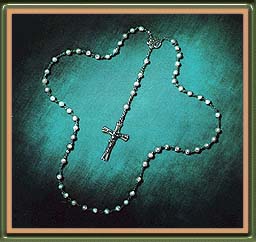|
|
|

The Irish Origin
of the
~ Rosary ~
![]()
|
As a youngster, I learned that St. Dominic was given the Rosary by the Blessed Virgin, and accepted that story of invention by divine intervention. Many years later, I learned that anecdote was only an austere version of the true story, simplified for young minds. The true origin of the Rosary is quite different, more interesting, and predates St. Dominic! Theologians have traced the origin of the Rosary back to the Ninth century, and a form of prayer that evolved in the monasteries of the early Irish church. Prayer and labor filled the days of the Irish monks, and one of the most important forms of monastic prayer was the daily chanting of the 150 psalms of David. Lay people around the monastery would hear the psalms every day as they were sung or recited, and the beauty of this form of prayer intrigued them. They yearned to join in, but the psalms were too long to memorize, copies could not be found since printing was rare, and few knew how to read Latin anyway. The lay people were however, determined to adapt this prayer form for their own use. Sometime around 800 AD, the people's desire to participate led to their reciting The Lord's Prayer in response to every psalm recited by the monks. As this form of devotion became popular, people began to carry leather pouches of 150 pebbles, in order that they might keep count of their daily prayers when they were not in hearing distance of the monastery. A thin rope with 150 knots became less of a burden and soon replaced the bag of stones. The Celtic infatuation with the number three, soon saw the prayer rope evolve into a rope of 50 knots to be said three times, and this became an accepted standard. When the Irish missionary monks began to travel and evangelize Europe, this form of devotion was brought with them. In some areas, clergy and lay people began to recite the Angelic Salutation which makes up the first part of the Hail Mary in response to the psalms. St. Peter Damien, who died in 1072, was the first to mention this form of prayer, the popularity of which led to the daily recitation of 50 Angelic Salutations on a knotted or beaded prayer string. During the 13th century, the recitation evolved into yet another form. Medieval theologians began to interpret the 150 psalms as veiled prophesies about the life, death, and resurrection of Jesus, and they composed a series of Psalters, or praises, based on each interpretation. Soon 150 Psalters in honor of Mary were also composed. In order to fit the existing prayer string, the Psalters were divided into three "rosariums" or bouquets of 50 each. This was the form that St. Dominic knew, and promoted. With the Church's emphasis on unity, it was inevitable that a planned combination of all the prayer forms was prescribed as a standard. The first step toward that standard took place about 1365 when Henry of Kalkar, Visitator of the Carthusian Order, divided the 150 salutations into decades of 10, with an Our Father preceding each. Around 1409, another Carthusian named Dominic the Prussian, wrote a book which attached a Psalter of 50 thoughts, about the lives of Jesus and Mary, to a Rosarium of 50 Hail Marys. The division of the 50 Hail Marys into five groups of ten, or decades, with an Our Father before each, gave the modern Rosary its form, yet the evolution was not over. In 1470, the Dominican, Alan of Rupe, founded the first Rosary Confraternity, thereby establishing the Dominican Order as the foremost missionaries of the Rosary. Then, during the Renaissance, the medieval form of a thought for each bead was abandoned in favor of a shorter version with a thought for each of the fifteen decades. These thoughts took the form of narratives, one of the most popular sets of which was written by St, Louis de Montfort around 1700. The fifteen narratives were divided into five Joyful, five Sorrowful, and five Glorious Mysteries in the lives of Jesus and Mary, and the Rosary itself became a string of 50 beads to be prayed three times, with each time representing one of the three sets of Mysteries. In spite of centuries of evolution and change, the Rosary's Irish origins are still evident. The number of Hail Marys in the Joyful, Sorrowful, and Glorious Mysteries still total 150 - the exact number of psalms chanted by the early Irish monks in their monasteries, and answered by the faithful Irish outside in a responsorial pattern that became today's most popular form of devotion. It is significant that when Mary visited Knock in 1879, she was holding a Rosary. |
![]()
| St. Patrick ~ The Story | |
| St. Brigid of Ireland | |
| St. Valentine's Irish Connection | |
|
|
![]()
| St. Patrick's Day Silliness |
![]()





Special thanks go to the Ancient Order of Hibernians, and Mike McCormack, National Historian for this excerpt.

|
This page was created with Netscape Navigator Gold ~*~ Under Construction ~*~
And last updated on March 3, 2000 |